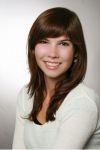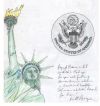 | Mrs. Renate Rave-Schneider reflects the DAG excursion 2011
Am sonnigen Himmelfahrtstag trafen sich um 8.30 29 Personen der DAG, darunter 9 Architekturstudenten aus Fresno/ Kalifornien, um zur Besichtigungsfahrt per Omnibus zu starten.
Im gut besetzten und klimatisierten Bus ging es durchs Münsterland, über Marl mit seinen chemischen Werken und Gladbeck in zügiger Fahrt nach Düsseldorf, wo wir bereits nach gut zwei Stunden ankamen und dank des
routinierten Busfahrers Peter sogar einen Parkplatz in der Nähe des Fernsehturms ergattern konnten.
Während der Fahrt sprach Herr Prof. Martin Korda auf Englisch über Münsteraner und deutsche Architekten speziell und allgemein, über Duisburg -Kaiserberg und die Ruhrmetropole Essen, die durch Alfred Krupp mit seinen Waffen - und Kanonenproduktionen zur (traurigen) Berühmtheit gekommen war.
Die amerikanischen Studenten, die teilweise recht interessiert zuhörten, vollendeten mit geübten, blitzschnellen Strichen und Anwendung von Farbstiften Zeichnungen von Münsteraner Gebäuden in ihren Skizzenheften:
das Rüschenbeck-Haus, das Rathaus, das Marktcafe, den Leonardo-Campus, Krameramtshaus und Stadtbücherei, Kontrast von alt und neu.
Um 11 Uhr empfing uns am Aufgang zum Fernsehturm Ruth Orzessek-Kruppa vom Stadtplanungsamt Düsseldorf, um uns auf einer gut zweistündigen Führung die Besonderheiten des Medienhafens zu zeigen und zu erläutern.
In knapp einer Minute ging es im Aufzug auf den 168 m hohen Turm, von wo aus sich ein grandioser Panoramablick über Düsseldorf und das Rheintal bis nach Neuss und Essen bot.
In der Sonne glänzt die grünsilberne Glaskuppel des Hyatt-Hotels, wir sehen Vodaphone und das Ende der Kö, wir sehen das Stadttor, den Rheinturm, den Landtag und Park, vieles davon mit Städtebauförderungsmitteln gebaute Objekte. Die Schiffe im kleinen Yachthafen blinken auch in der Sonne.
Der Medienhafen mit Gastronomie, Hotels und Unterhaltungs-sowie Sportbetrieben verdankt seinen Namen eigentlich ausschließlich dem WDR, der ja seinen Ursprungssitz in Köln hat, aber in der Landeshauptstadt NRW natürlich auch mit einem Landesstudio präsent sein muss.
Ein markantes Merkmal am Medienhafen sind die Gehry-Häuser, die tanzenden Türme, aber auch ein Münsteraner Architekt namens Thomas Rempen war mit Projekten im ersten Entwurf dabei.
Nach so viel Sightseeing aus luftiger Höhe wollen wir nun den Medienhafen und das Rheinufer auf Schusters Rappen erkunden: es weht ein frischer Ostwind. Der Hafen ist sehr steinern, übrigens hat der Münsteraner Kreativkai in Münster auf mich eine ähnliche Wirkung.
Warum so steinern?
Wir erfahren, dass im Hafenbereich keine Begrünung vorgesehen ist, futuristisch und nüchtern-strukturiert soll es wohl sein.
Über eine Brücke geht es zum Rheinufer und zum Hyatt:
Joggen, Walken, Biken am Rhein, alles ist möglich, es gibt kilometerlange Laufmöglichkeiten.
Anschliessend ab 13 Uhr werden wir auf der Terrasse des Eigelsteins, welches an der Schnittstelle des Hafens zur Hammer Str. liegt, gut bedient, können unter fünf verschiedenen Gerichten auswählen und ein leckeres Kölsch probieren, was eine Eigelsteiner Spezialität ist und woran hier kein Düsseldorfer Anstoß nimmt. Sie wissen ja, die Rivalität zwischen Kölnern und Düsseldorfern...... oder ist das auch nur eine Mär?
Am Nachmittag werden wir dann über Düsseldorf -Unterbach ins Neandertal gefahren, wo eine erfahrene Museumspädagogin uns durch das eigenwillig und architektonisch interessante Museum führt, welches unweit der Fundstelle der Neanderthaler liegt.
Wir erfahren vieles Neue: wir bekommen einen Eindruck anhand einer großen Sanduhr von der zeitlichen Dimension die seit der Entstehung der Erde, seit Auftauchen der ersten Menschen und der Neanderthaler seit Jesu Geburt bis heute verstrichen ist.
Auch können wir nachempfinden, welche Werkzeuge der Neanderthaler benutzte, was er aß, wie er sich kleidete.
Nach einer Kaffeepause geht es an diesem ereignisreichen Tag froh und erfüllt nach Münster zurück. Renate Rave-Schneider, 14.06.2011
|
|
 | Cornel Arthur Tulak
Cornel Arthur Tulak wrote these greetings from his new office in Hawaii. |
|
 | Katie Grosser, daughter of an American-German couple with American and German citizenship, living actually with her family in Germany and studying Communication and Political Science at the WWU published an article about the DAG Münster in the German-American newspaper "The Atlantic Times". The intention of this newspaper is to bring more informations on Germany to Americans. The article is titled "A circle of friends".
“A Circle of Friends”
A small society in Münster is doing its part to promote German-American friendship
They share an enthusiasm for the American way of life. They return some of the hospitality they experienced in the USA. And sometimes they speak openly about their opinions – for that is what friendship is all about, according to the members of the German-American Society in Münster.
Germany in the 1980s: The Peace movement is on the agenda and anti-US and anti-NATO feelings dominate the country. Public figures such as writer Heinrich Böll are protesting against the American military presence in Germany, specifically against its nuclear weapons stationed in West Germany.
It was this moment in Münster, a university town in North-Rhine-Westphalia, that a group of around sixty people decided to come together to send a signal that German-American friendship wasn’t a lost cause. And so, the Deutsch-Amerikanische Gesellschaft (DAG) – or the German-American Society - was born.
By now, most of the founding members, some of which were American professors, students and citizens living in Münster at the time, are elderly or have passed away. But DAG is still very much alive. And it still has similar goals.
“One of our jobs is to spread information about the U.S. and American issues” said DAG’s current treasurer, Ulrich Kuschnerus. “We represent German-American friendship.”
Chairman Martin Korda emphasized a more personal side to DAG. “All we really want to do is return some of the hospitality we ourselves experienced”, he said. That is why the DAG is an important first point-of-contact for many American students and professors who come to Münster.
Highlights of DAG’s calendar are the annual Thanksgiving meal, Fourth of July festivities, New Year’s concert and, finally, day trips with American students. DAG values education and frequently invites its members and other interested individuals to lectures and podium discussions on American-related topics, such as American elections, travel reports and German migration to the US.
More importantly, Korda does not see DAG as an integrating platform for Americans coming to Germany. “DAG isn’t a society for foreigners,” he said. “We aren’t there just to cheer up Americans abroad – we are a society of hosts.”
Perhaps the reason for this bent on hospitality is that most DAG’s members have a profound relationship with the US themselves. Kuschnerus, for example, spent a year attending High School in the US in the 1960s and still wears his class ring to this day.
“I’ve kept in contact to my host family all these years”, he said. “That year in America was decisive for me. To live in a new and different culture is very important – if only to find out that despite all the differences, we are all humans with our own weaknesses and strengths.”
Other German members have American spouses, have lived and worked in the US or have simply spent a great vacation there and decided to join the society. These people enjoy and celebrate the American way of life – particularly the typically American openness and readiness to welcome guests into one’s circle.
This does not mean, however, that DAG can’t be critical of the US. “We cultivate friendship,” said Kuschnerus, “and in a friendship, it’s important to be able to speak one’s mind once in a while”.
He lamented that while the American way of life is great, it is too often the only life Americans know or care about. “In the past, Americans got out of America through the military and came to Europe,” he said. “There also used to be more students. The United States’ problem is that too many Americans believe that only their way is right. They need to broaden their horizons”.
Like any other organization, DAG faces problems. Korda acknowledges that most members have reached a ripe old age and that the younger generations are harder to pin down. Students are usually very interested in the society’s work but they come to Münster for a few years and then leave again, whereas full-time workers seldom have the time to really get involved with DAG according to Kuschnerus.
Most new members are retirees. Korda wishes he could get more young people to participate and has hopes for the future that they might be drawn into the society for special projects instead of long-term engagements. “It would be a start, at least,” he said.
But in spite of all that, Korda is proud of the society’s achievements. When the American ambassador visited in January, Korda was one of the few chosen to attend a personal dinner with him. And it is often the little things that make the difference. Each year, DAG organizes a meeting for students interested in spending a year in the US, giving them tips and telling them which organizations to contact.
Helping others gain experiences can be very gratifying. Sometimes it’s even just an evening spent together with new friends, talking and learning about their lives that shows Korda how important DAG really is. “A circle of friends” is how Korda describes the society. Kuschnerus says what is great about DAG is that you “always meet new people”.
And during a time when the world seems to be opening up to the US again, it is nice to know that there were people who promoted friendship even in the most difficult of days. |
|
 | Thanks and acknowledgements for the German-American Society
At the beginning of 2009 Consul General oft the USA Mr. Matthew G. Boyse had invited representatives of all organizations in his region, who are determined to promote the relations between the USA and Germany, for a discussion into his Düsseldorf residence. About 60 were present, Mayors, Boards of partnership committees, Chairmen of German-American Societies, organizers of Student Exchange Programs and City Partnerships. In the name of the Ambassador if the USA Excellency William R.Timken he thanked all persons and organizations for their engagement because they all completed a great job working jointly so much for the understanding of the people and the nations. Münster was represented by Mrs. Christiane Lösel, department head for City Partnerships of the City of Münster, Mr. Horst Denecke Chairman of the Promoting Society Münster-Fresno and by Prof. Martin Korda, Chairman of the German-American Society Münster. Consul General Boyse presented a document to the representatives of the city of Münster together with thanks and acknowledgement from the Ambassador regarding the promotion of the City Friendship between Münster and Fresno, California. Representing the German-American Society Münster Prof. Korda received a document underlining the merits of the society regarding the relations between both nations, the promotion of student exchange activities and the enrichment of cultural relations. Prof. Korda was presented another document appreciating his personal engagement, which he had demonstrated so many years. Consul General Boyse emphasized how important he himself sees these acknowledgements as the number of engaged people working for good relations between the nations in Germany and particular in Nordrhein-Westfalen is higher than expected. To express these thanks he sees as a personal matter of concern since long. Ambassador Timken confirmed Mr. Boyse in his intentions and submitted as well thanks and acknowledgements. |
|
 | Ambassador oft he USA in Münster
On July 17th, 2007, the Ambassador of the United States of America in Germany Mr. William Timken jun. visited the City of Münster and took opportunity to sign in the guestbook of DAG. |
|
|
